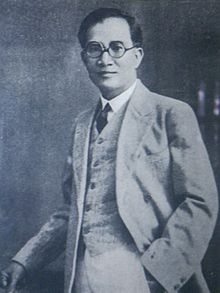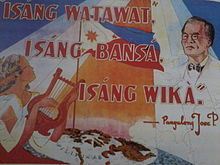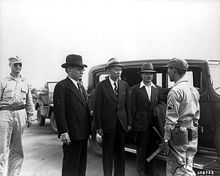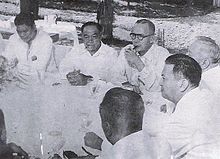Jose P. Laurel
José Paciano Laurel y García[e] (March 9, 1891 – November 6, 1959) was a Filipino politician, lawyer, and judge, who served as the President of the Second Philippine Republic from 1943 to 1945, which was a Japanese ally during World War II.[3] While a teen, Laurel was indicted for attempted murder when he almost killed a rival suitor of the girl he stole a kiss from with a fan knife.[9] Following the ratification of the 1935 Constitution and the establishment of the Commonwealth of the Philippines, Laurel was appointed Associate Justice of the Supreme Court on February 29, 1936.726 (1940) was a seemingly innocuous case involving a challenge raised by a private citizen to a traffic regulation banning kalesas from Manila streets during certain afternoon hours.Social justice means the promotion of the welfare of all the people, the adoption by the Government of measures calculated to insure economic stability of all the competent elements of society, through the maintenance of a proper economic and social equilibrium in the interrelations of the members of the community, constitutionally, through the adoption of measures legally justifiable, or extra-constitutionally, through the exercise of powers underlying the existence of all governments on the time-honored principle of salus populi est suprema lex.Social justice, therefore, must be founded on the recognition of the necessity of interdependence among divers and diverse units of a society and of the protection that should be equally and evenly extended to all groups as a combined force in our social and economic life, consistent with the fundamental and paramount objective of the state of promoting the health, comfort, and quiet of all persons, and of bringing about "the greatest good to the greatest number.Laurel was among the Commonwealth officials instructed by the Japanese Imperial Army to form a provisional government when they invaded and occupied the country.On the other hand, guerrilla activities and Japanese retaliatory measures brought the peace and order situation to a difficult point.Resorting to district-zoning and domiciliary searches, coupled with arbitrary arrests, the Japanese made the mission of Laurel's administration incalculably exasperating and perilous.[22] On October 20, 1943, the Philippine-Japanese Treaty of Alliance was signed by Claro M. Recto, who was appointed by Laurel as his Foreign Minister, and Japanese Ambassador to Philippines Sozyo Murata.[20] Shortly after the inauguration of the Second Philippine Republic, President Laurel, together with cabinet Ministers Recto and Paredes flew to Tokyo to attend the Greater East Asia Conference which was an international summit held in Tokyo, Japan from November 5 to 6, 1943, in which Japan hosted the heads of state of various component members of the Greater East Asia Co-Prosperity Sphere.Beginning in March 1945, President Laurel, together with his family, Camilo Osías, Benigno Aquino Sr., Gen. Mateo M. Capinpin, and Jorge B. Vargas evacuated to Baguio.Shortly after the city fell, they traveled to Tuguegarao, where they embarked a bomber plane to Japan via Formosa (now Taiwan) and Shanghai, China.While in prison, he was not allowed to have any reading material except The World in 2030, a book by the Earl of Birkenhead that he received as a gift from his son Salvador Laurel.[2] On July 23, 1946, Laurel, together with Osias, Aquino, and his son Jose III, left Tokyo for Manila, having been turned over to the Republic of the Philippines.One month later, he was placed under technical custody at his Peñafrancia house in Paco, Manila but rather than accepting the given conditions, he preferred to be imprisoned at the New Bilibid Prison in Muntinlupa, Rizal.Magsaysay appointed Laurel head of a mission tasked with negotiating trade and other issues with United States officials, the result being known as the Laurel–Langley Agreement.Laurel was also named as chairman of the Senate Committee on Education, which he held when he sponsored in 1955 a bill that would make José Rizal's two novels, Noli Me Tángere and El filibusterismo, as compulsory readings in all universities and colleges.The home was one of three residences constructed by the Laurel family, the other two being in Tanauan, Batangas and in Paco, Manila (called "Villa Peñafrancia").On his 68th birthday on March 9, 1959, President Carlos P. Garcia conferred him the award of Philippine Legion of Honor with the degree of Chief Commander.On November 6, 1959, at 1:00 in the morning, he died at Our Lady of Lourdes Hospital in Manila,[31] from a massive heart attack and cerebral hemorrhage.












President of the PhilippinesManuel L. QuezonSergio OsmeñaVice PresidentRamon Avanceñade factoBenigno Aquino Sr.Minister of the InteriorJorge B. VargasCommissioner of JusticeTeófilo SisonSenator of the PhilippinesAntero SorianoClaro M. Recto5th districtAssociate Justice of the Philippine Supreme CourtGeorge MalcolmSenate Majority LeaderFrancisco EnageBenigno S. AquinoSecretary of the InteriorTeodoro M. KalawFelipe AgoncilloTanauan, BatangasCaptaincy General of the PhilippinesSpanish East IndiesSanta MesaManilaTanauanBatangasNacionalistaKALIBAPIPacencia HidalgoJose B. Laurel Jr.Jose S. Laurel IIISotero Laurel IISalvador LaurelArsenio LaurelAlma materUniversity of the Philippines ManilaUniversity of Santo TomasYale UniversitySecond Philippine RepublicJapaneseWorld War IIDiosdado MacapagalEmilio Aguinaldo1899 Malolos ConstitutionChinesemestizoPaciano RizalColegio de San Juan de Letranfan knifelaw schoolManila High SchoolUniversity of the Philippines College of LawGeorge A. MalcolmSupreme Court of the PhilippinesPhilippine bar examinationMaster of LawsYale Law SchoolJ.S.D.Supreme Court of the United StatesSupreme CourtCourt of Appeals of the District of ColumbiaUnited StatesEuropeinternational lawOxford UniversityEnglandUniversity of ParisFrancecodificationJusticeGovernor-GeneralLeonard WoodUpsilon Sigma PhiPhilippine Senateelected1935 ConstitutionCommonwealth of the PhilippinesAssociate JusticeMarbury v. Madison5 U.S. (1 Cranch) 137 (1803)National Assemblyjudicial reviewdue process of lawkalesaspolice powersocial justiceaphorismsalus populi est suprema lexSecretary of JusticeChief JusticeJosé Abad SantosWack Wack Golf and Country ClubCity of Greater Manila.45 caliber pistolFar Eastern UniversityNicanor Reyes Sr.Philippine General HospitalKempetaiTeodoro AgoncilloReference styleHis ExcellencyJapanese occupation of the Philippineswar collaboratorBataanImperial Japanese Army AcademyTokyo Imperial UniversityNational Museum of Fine ArtsJosé YulohungerguerrillaForeign MinisterGreater East Asia Conferenceheads of stateGreater East Asia Co-Prosperity SphereEmpire of JapanPan-AsianismcolonialismCommonwealth governmentOsaka AirportJose Laurel IIILeyte IslandBattle of Leyte